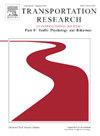使用澳大利亚自然驾驶研究数据来探索年轻新手和有经验的司机的非驾驶任务参与
IF 3.5
2区 工程技术
Q1 PSYCHOLOGY, APPLIED
Transportation Research Part F-Traffic Psychology and Behaviour
Pub Date : 2025-05-17
DOI:10.1016/j.trf.2025.05.010
引用次数: 0
摘要
了解年轻司机和经验丰富的司机在非驾驶任务参与方面的差异,对于制定有效的政策来减少分心驾驶和分心相关的撞车事故至关重要。这项研究调查了不同驾驶环境下年轻(17-18岁)和有经验(25-62岁)司机参与非驾驶任务的普遍性和类型,包括是否有乘客、车辆是否在行驶、不同的光线和天气条件。数据来自澳大利亚青年自然主义驾驶研究(YANDS)和澳大利亚自然主义驾驶研究(ANDS)。从每个数据集中随机选择42个行程(总共84个行程)。为保证数据质量,不包括持续时间少于1分钟或超过1小时的行程。分析人员从视频片段中手动编码了29种不同类型的非驾驶任务参与事件。采用负二项分布和驾驶员水平随机效应的广义线性混合模型(GLMM)来评估驾驶员人口统计学和驾驶环境对非驾驶任务参与的影响,并考虑了同一驾驶员的多次出行。年轻和有经验的司机都经常从事非驾驶任务。经验丰富的司机将45.3%的驾驶时间用于非驾驶任务,每1.8分钟启动一次任务。相比之下,年轻司机将58.4%的驾驶时间用于非驾驶任务,每3.1分钟启动一次任务。年轻司机更有可能从事较长时间的任务,如说话或唱歌。相比之下,经验丰富的司机倾向于从事较短、分散的任务,比如与中控台互动或调整非关键的车辆控制。此外,与年轻司机相比,有经验的司机更有可能在车辆静止时开始非驾驶任务。年轻司机似乎不太熟练,在车辆行驶过程中,他们往往更频繁地执行更长时间的任务。相比之下,经验丰富的司机表现出更好的自我调节能力,通常在车辆静止时从事非驾驶任务。这些研究结果突出表明,需要采取有针对性的干预措施,教育年轻司机了解长时间非驾驶任务的风险,并促进更安全的参与策略,这对于制定道路安全政策以减少与分心有关的撞车事故至关重要,特别是在年轻司机中。本文章由计算机程序翻译,如有差异,请以英文原文为准。
Using Australian Naturalistic Driving Study data to explore non-driving task engagement across young novice and experienced drivers
Understanding the differences in non-driving task engagement between young and experienced drivers is crucial for developing effective policies to reduce distracted driving and distracted-related crashes. This study examined the prevalence and types of non-driving task engagement among young (17–18 years) and experienced (25–62 years) drivers across various driving contexts, including the presence of passengers, whether the vehicle was in motion, and different light and weather conditions. Data were drawn from the Young Australian Naturalistic Driving Study (YANDS) and the Australian Naturalistic Driving Study (ANDS). Forty-two trips were randomly selected from each dataset (totalling 84 trips). To ensure data quality, trips lasting less than one minute or more than one hour were excluded. Analysts manually coded 29 different types of non-driving task engagement events from video footage. Generalized Linear Mixed Models (GLMM) with a negative binomial distribution and driver-level random effects were conducted to assess the impact of driver demographics and driving context on non-driving task engagement, accounting for multiple trips by the same driver. Both young and experienced drivers frequently engaged in non-driving tasks. Experienced drivers spent 45.3 % of their driving time on non-driving tasks, initiating a task every 1.8 min. In contrast, young drivers spent 58.4 % of their driving time on non-driving tasks, initiating a task every 3.1 min. Young drivers were more likely to engage in longer-duration tasks, such as talking or singing. In contrast, experienced drivers tended to engage in shorter, discrete tasks, like interacting with the centre console or adjusting non-critical vehicle controls. Additionally, compared to young drivers, experienced drivers were more likely to initiate non-driving tasks when the vehicle was stationary. Young drivers appeared less adept, often engaging in longer tasks more frequently while the vehicle was in motion. In contrast, experienced drivers demonstrated better self-regulation, typically engaging in non-driving tasks when the vehicle was stationary. These findings highlight the need for targeted interventions to educate young drivers about the risks of prolonged non-driving tasks and promote safer engagement strategies, which are critical for shaping road safety policies to reduce distraction-related crashes, particularly among young drivers.
求助全文
通过发布文献求助,成功后即可免费获取论文全文。
去求助
来源期刊
CiteScore
7.60
自引率
14.60%
发文量
239
审稿时长
71 days
期刊介绍:
Transportation Research Part F: Traffic Psychology and Behaviour focuses on the behavioural and psychological aspects of traffic and transport. The aim of the journal is to enhance theory development, improve the quality of empirical studies and to stimulate the application of research findings in practice. TRF provides a focus and a means of communication for the considerable amount of research activities that are now being carried out in this field. The journal provides a forum for transportation researchers, psychologists, ergonomists, engineers and policy-makers with an interest in traffic and transport psychology.

 求助内容:
求助内容: 应助结果提醒方式:
应助结果提醒方式:


